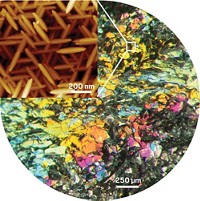Advertisement
Grab your lab coat. Let's get started
Welcome!
Welcome!
Create an account below to get 6 C&EN articles per month, receive newsletters and more - all free.
It seems this is your first time logging in online. Please enter the following information to continue.
As an ACS member you automatically get access to this site. All we need is few more details to create your reading experience.
Not you? Sign in with a different account.
Not you? Sign in with a different account.
ERROR 1
ERROR 1
ERROR 2
ERROR 2
ERROR 2
ERROR 2
ERROR 2
Password and Confirm password must match.
If you have an ACS member number, please enter it here so we can link this account to your membership. (optional)
ERROR 2
ACS values your privacy. By submitting your information, you are gaining access to C&EN and subscribing to our weekly newsletter. We use the information you provide to make your reading experience better, and we will never sell your data to third party members.
Materials
How Nanotubes Get Color
Tiny tubes’ coloration mechanism, different from other colorful materials such as gold nanoparticles, belies their metallic nature
by Carmen Drahl
January 9, 2012
| A version of this story appeared in
Volume 90, Issue 2
The colors of armchair carbon nanotubes—so named for the arrangement of their honeycomb-like carbon building blocks—are determined by factors different from those that color other nanomaterials, researchers report (J. Am. Chem. Soc., DOI: 10.1021/ja209333m). Size-dependent colors in nanomaterials are common, but underlying electronic properties usually provide the color explanations. For instance, the color of metallic gold nanoparticles depends on the wavelength at which their free electrons collectively oscillate, known as plasma resonance frequency. And semiconducting nanoparticles, or quantum dots, have the colors they do because their size changes the energy gap between their key molecular orbitals. Erik H. Hároz and Junichiro Kono of Rice University and their colleagues sorted sets of armchair nanotubes and obtained their absorption and Raman spectra. Although the nanotubes are metallic, their colors don’t depend on plasma resonance, the researchers learned. Instead, the color depends on how light is absorbed by high-energy electron-hole pairs called excitons, and it differs depending on the diameter of the tubes.




Join the conversation
Contact the reporter
Submit a Letter to the Editor for publication
Engage with us on Twitter